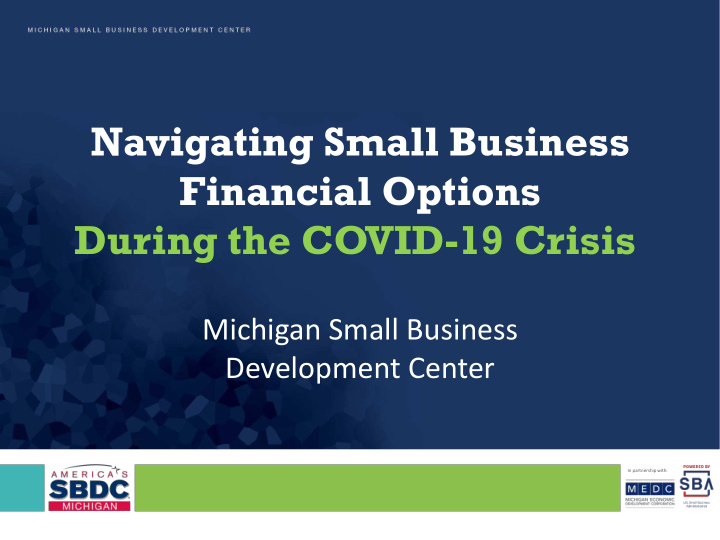



Navigating Small Business Financial Options During the COVID-19 Crisis Michigan Small Business Development Center In partnership with:
The Michigan SBDC A statewide network funded in part through a cooperative agreements with the • U.S. Small Business Administration (SBA) • Michigan Economic Development Corporation (MEDC) • Matching funds from Local Network partners in each region. • 11 Regional Offices to serve all 83 counties in the state
CARES Act • Economic Injury Disaster Loan (EIDL) • Emergency Economic Injury Grant (EEIG) • Paycheck Protection Program (PPP) • Other – Enhanced Unemployment – SBA Express Loan – SBA Loan Deferral
CARES Act
Economic Injury Disaster Loan (EIDL) The SBA’s Economic Injury Disaster Loans offer up to $2 million in assistance and can provide vital economic support to small businesses to help overcome the temporary loss of revenue they are experiencing.
Economic Injury Disaster Loan (EIDL) Use of Funds: • Fixed debts (rent, utilities etc.) • Payroll • Accounts payable • Some bills that could have been paid had the disaster not occurred. Criteria for Approval: • Acceptable Credit History • Ability to repay the SBA loan
Economic Injury Disaster Loan (EIDL) Snapshot: • Funds come directly from the U.S. Treasury • No cost to apply and no closing costs • No obligation to take the loan, if offered • The maximum unsecured loan amount is $25,000 • No personal guarantee for loans under $200,000 • Automatically deferred for 12 months • Maximum loan amount $2 million • Interest rates – Small Businesses 3.75 % – Most Private, Non-Profits 2.75 % • Terms up to 30 years • Eligibility based on the size, type of business and financial resources
Applying for the EIDL You can apply directly to SBA’s Disaster Assistance Program at: https://covid19relief.sba.gov/#/
Applying for the EIDL You can apply directly to SBA’s Disaster Assistance Program at: https://covid19relief.sba.gov/#/ Other Documents: • Required to provide: • Business tax returns for three prior years • Personal tax returns for each principal owning 20% or more of the applicant • 2019 Federal Tax Returns • Personal Financial Statements (SBA Form 413) for each applicant and principal owning 20 % or more of the applicant • Applicant’s debt Schedule (SBA Form 2202)
Emergency Economic Injury Grant (EEIG) The CARES bill introduced a new measure to allow businesses in operation on January 31, 2020 to receive essential funding as quickly as possible. The SBA can provide up to $10,000 within three days of the application.
Emergency Economic Injury Grant (EEIG) EEIG funds can be used for the following: • Providing sick leave to employees unable to work due to direct effect of COVID-19; • Maintaining payroll during business disruptions during slow- downs; • Meeting increased supply chain costs; • Making rent or mortgage payments; and, • Repaying debts that cannot be paid due to lost revenue. The EIDL grant does not need to be repaid, even if your disaster loan application is later denied.
Paycheck Protection Program (PPP) The Paycheck Protection Program is a loan designed to provide a direct incentive for small businesses to keep their workers on the payroll.
PPP Eligibility & Uses Snapshot: • No loan fees • No collateral • No prepayment penalties • No personal guarantee • Automatically deferred for 6 months • Can borrow 250% of average monthly payroll cost • Maximum loan amount $2 million • Interest rate - 1% on amount not forgiven • Term - 2 years • Eligibility based on the size, type of business and financial resources • Loans forgiven if used on payroll costs, rent, mortgage, insurance and utilities.
How Much Can I Borrow? 250% of your average monthly payroll expense. Example – if your average monthly payroll is $25,000/month, then your loan amount would be: $25,000 x 2.5 = $62,500
PPP Loan Forgiveness Loan forgiveness equals the sum of the following expenses paid during the eight-week period that begins on the loan origination date. • Payroll • Rent/lease • Utilities • Mortgage/debt interest 75% of forgiven amount must be payroll expenses. You will be required to submit documentation to your lending institution verifying above expenses to be eligible for loan forgiveness.
Applying for the Loan “The estimated time for completing the application, including gathering data needed, is 8 minutes.” Supporting Payroll Records to be submitted with PPP application: • Third party payroll administrator records for the applicable period. • List of all employees with their total compensation. For the purposes of this application, any employee with total compensation over $100,000 should be listed as $100,000. • Copies of quarterly 941 payroll tax reports filed with the IRS and a copy of W-3 (note 941 statements may not be available for Q1 of 2020). • Records of payments made for – vacation, parental, family, and medical or sick leave. – employer paid group health care benefits, if applicable. – employer paid retirement plan benefits, if applicable. – state or local taxes assessed on the compensation of employees, if applicable.
Find a Lender https://www.sba.gov/paycheckprotection/find
CARES Act
CARES Act
Other Programs – Enhanced Unemployment – SBA Express Loan – SBA Loan Deferral
For More Information www.sbdcmichigan.org/small-business-covid19/
For More Information • www.sbdcmichigan.org/small-business-covid19 • www.sba.gov/page/coronavirus-covid-19-small- business-guidance-loan-resources • www.sbam.org/Resources/COVID-19-Resources • http://paycheckprotectionprogrammichigan.com • SBA Disaster Customer Service Center (800) 659-2955 • disastercustomerservice@sba.gov • careresurces@micpa.org
Questions
Recommend
More recommend